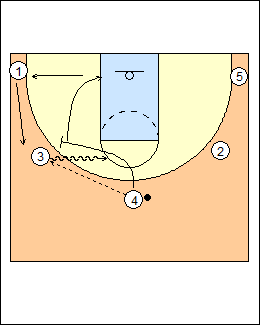5-out youth motion
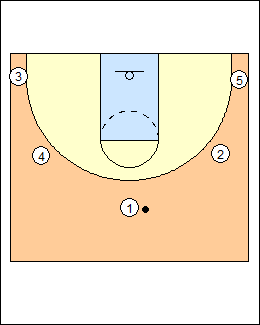 | 1 5-out motion is a common youth offence because the court is spread, players are moving, and they are basically interchangeable after the first pass. 1) Fast break 2) Cutting series 3) Dribble penetration 2) Dribble-at 5) Screen away 6) Ballscreen 7) Handback 8) Post-up For spacing, player positions are outside the 3-point line at the point (top of the key), wings, and corners (or short corners, halfway between the basket and each sideline). Players are basically interchangeable after the first pass. When you get the ball, square to the basket in triple threat and hold for at least a one-count to read the action. For a teaching progression, see Youth Basketball - Offence, including Tactics - 3-spot pass-cut-fill, Layups - Open-post motion. Coach Mac - 5-Out Motion Complete Coaching Guide - progressions: - Basic cutting - Screening away - On-ball screen - Dribble at See Blog post - 5-Out Motion, Offences - Youth motion, MacKay single-double gaps, also Perkins open-post, Petitgoue open-post, Huggins open-post, Passing game. |
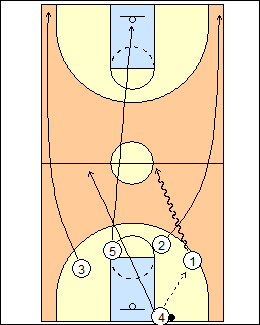 | 1) Fast break Open-post offence can start with a traditional fast break where 2 and 3 run wide and 5 (or the first big) runs to the rim. Two players should be designated to inbound and bring up the ball after the other team scores, e.g., 4 and 1. They can alternate roles. David Faucher - you can change positions to give everyone a chance to handle the ball. If everyone can handle the ball reasonably well, whoever rebounds the ball is the point guard. Variation - whoever rebounds can push the ball or outlet to 1 and be the trailer. |
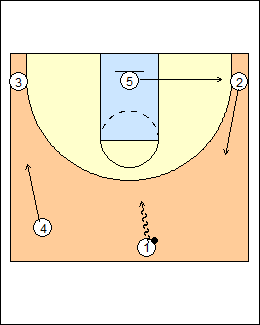 | 3 2 bounces off the baseline to the right wing, 5 replaces 2 in the corner. Option - 4 screens down for 3. See Offence - Perkins open-post (4 and 5 screen down for 3 and 2 in the corners). Transition off Misses - on a defensive re bound, the first big rim runs then gets out to the short corner or corner (for 5-out) opposite the ball. KG Basketball - 5-Out DDM - initial 5-out spacing has small gaps (defences turn into almost a 1-2-2 zone), and he still wants a rim runner, so he uses a 4-out 1-in entry to get into 5-out. Adam Spinella - Hoiberg 5-Out Concepts - 5-out spacing allows for backcuts, the rim is vacated. From 4-out 1-in, 5 can gut cut out top for a pass (then with a 45 cut from the weakside wing). Facundo Petracci - from 4-out 1-in, 5 can flash to the top of the key when the ball goes weakside. Tyler Coston - Race and Space Overview - keep the rim open as much as possible, hunt that space with the dribble, he doesn't want players cutting to the rim all the time (there is no rim runner).  |
 | 2) Cutting series Basket cut, blast cut, backcut. See Tactics - 3-spot pass-cut-fill. a) Basket cut To start, pass and cut on downhill passes (top to wing, wing to corner), see Offence - Youth motion. After you pass, speed cut to the basket (give-and-go), then space out and up. Players fill vacated spots, starting with the spot closest to the ball. You can dribble to shorten a pass. On a pass from the top to a wing, basket cut and go out the other side. Here 1 makes a backcut or face cut (if his defender doesn't jump to the ball), showing a target hand, then spaces out weakside, always seeing the ball (drop step at the rim). 3 fill cuts across the foul line, then pops out top for a pass, 4 fills behind 3, and 1 replaces 4 in the corner. 3 goes backdoor if denied, following behind 1 (a double cut, see Petitgoue open-post Revolve). Facundo Petracci - the cutter takes his defender all the way to the baseline, opens up, seeing the ball, clears weakside. Lason Perkins - 3 cuts to the "read spot" at the middle of the foul line and pops out towards the ball (not to the top of the key), shortening the pass. You can adopt a cutter rule for a poor ballhandler, he always cuts to the basket from the read spot. |
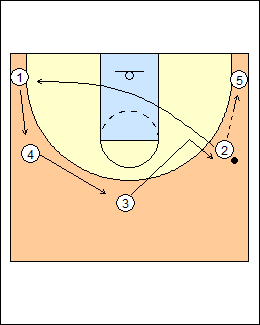 | 5 On a pass from a wing to the corner, basket cut and go out the other side. Here 2 cuts through and is replaced by 3, 4 and 1 fill behind. Because 3 is filling the spot closest to the ball, he combines his fill cut with a lead for the ball (a v-cut). Progression - corner player 5 can immediately dribble out to the wing and be replaced by cutter 2. Ball reversal tends to stall if there are passes to the corner, and if you get the ball in the corner, make a play, you can't hold it. Hal Wissel - pass to a baseline player only if he is open for a shot within range, or can make an easy pass inside, you can swing the ball more quickly if you keep it off the baseline. Cutters 5-out motion - avoid passing to the corner unless the player is a slasher or scorer, and keep the ball above the foul-line extended. Bob Huggins - use the corner every once in a while, drag a defender out. |
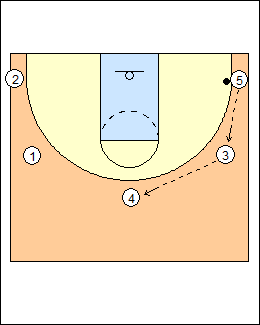 | 6 Pass and stay on uphill passes (corner to wing, wing to top), emphasizing quick ball reversal into pass-cut on the other side, the ball has already attacked the right side. For simple 5-out motion, basket cut only on a pass from the top to a wing, and don't pass to the corners, see Tactics - 3-spot pass-cut-fill. Steve Nash - pass and cut on any pass from the point to a wing. |
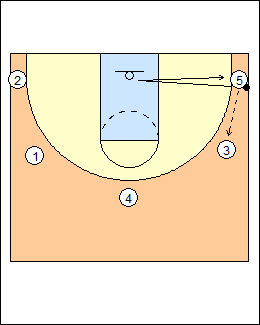 | 7 Options i) On a pass from a corner to the wing, basket cut and replace yourself (the only open spot). |
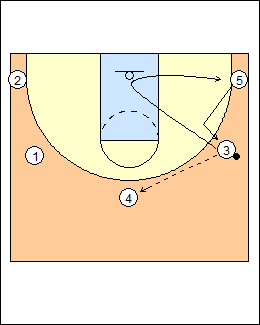 | 8 ii) On a pass from a wing to the top, basket cut and come out the same side. 3 basket cuts, 5 fills the wing, 3 replaces 5 in the corner. |
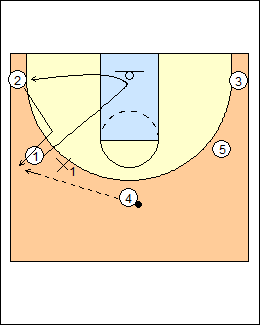 | 9 b) Backdoor cut Backdoor cut any time you are denied and the ballhandler is looking at you. Other players fill cut as needed. Here 1 backcuts, 2 fills, 1 replaces 2 in the corner (the pattern is the same if 1 passes to 4 then basket cuts). Young players may need to shorten the pass on a backcut, see Dribble-at, and Layups - Jr. NBA cutting. Option (shown) - 4 does not basket cut on passing to a blast cutter, see Offence - MacKay single-double gaps. Progressions Mike MacKay - How to Teach Cutting - in a single gap, backcut immediately if you are looked at, dribbled at, or pivoted at. Blast cut to fill behind. Elbow entry - 2 flashes to the elbow for a pass, 1 cuts backdoor, see Offences - New South Wales open-post motion, Passing game. Against pressure defence that denies passes, see Offence - 5-out dribble-attack continuity, Blog post - 5-out attack continuity series. Matt Hackenberg - 5-out screen away motion - if denied, backcut or downscreen and fill from behind (there are no v-cuts). A downscreen becomes a staggered screen on a pass to the other side.  |
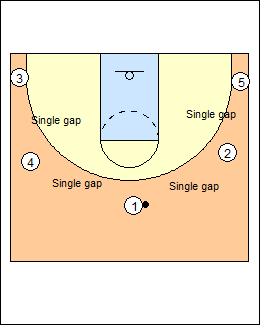 | 3) Dribble penetration See Offence - MacKay single-double gaps. Good defences can defend cutters, so a goal on offence should be to create and exploit gaps for dribble penetration. Mike MacKay - the problem with single gaps is stationary passes and quick help and recovery. Create a double gap by cutting a player. |
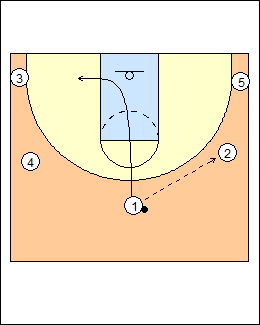 | 11 1 passes to 2 and basket cuts, creating a double gap. 4 does not immediately fill behind, as 2 needs time to look for the cutter and then possibly drive behind the cutter (a "draft" drive). Perkins - when replacing the cutter, wait until the ballhandler is done looking at the cutter. Coach Mac - once 1 has cut, 4 and 3 must fill the positions closer to the ball. Wissel - if you catch the ball on the wing outside your range, hold the ball for a count of two, look to a) pass inside to a player cutting or posting, b) drive and kick (especially when the ball is reversed from one wing to the other), c) balance the court by dribbling to the point. Cutters 5-out motion - if the player in front of you cuts, replace him, wait until the ballhandler is almost done looking at the cutter. Dribble-drive motion - cut away (corner cut) on a pass down, attack the double gap. See Scrimmage - Bigelow 3 on 3 with passers, Offence - 5-out dribble drive motion. |
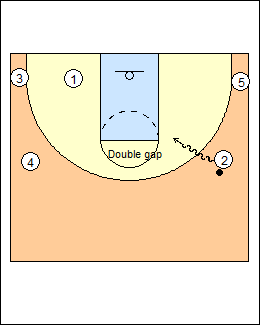 | 12 By holding (delaying a fill cut), 4 maintains a double gap for 2 to attack middle, a draft drive behind 1's cut. This is a static 1-on-1 but into a double gap. If 2 drives when 1 is in the middle of cutting, 1 should break off the cut.MacKay - the double-gap gives 4 space to blast cut to the ball on eye contact with 2, then attack immediately. The passer holds on a dynamic pass. Teaching Offensive Concepts - a double/triple gap, match-up advantage, or late clock is a green-light situation in a static 1-on-1. See Tactics - Wheel Movement. *** Dribble penetration draws help (two defenders play the ball), leading to a kick-out pass and often an extra pass for a shot or another drive. Often a teammate will cut to the basket on penetration. Penetrate-Pass-Pass - making the extra pass after an initial drive-and-kick re-opens the lane for another drive, keeps the defence in rotation and forces long closeouts. Thomaidis - penetration causes the defence to collapse, a pass out creates a long closeout, the extra pass is the one that defences have a hard time getting out to. They are always trying to create long closeouts, that is the most difficult defensive skill. Penetrate-penetrate is a turnover in practice. Sherman - avoid consecutive drives, penetrate pass pass. An exception is drive, kick, shot fake (re-expand the defence), then drive. Chris Oliver - Villanova Second Cuts - a teammate can basket cut on dribble penetration if their defender loses sight of them. Tyler Coston - Space to Hunt - in transition, hunt the "logo" off the dribble then cut to score with a "burn cut" from a corner or 45 (a defender loses vision, attack the back of their head). Score with 45 Cuts - a baseline drive opens up a weakside 45 cut as defenders help and drop (cover down). |
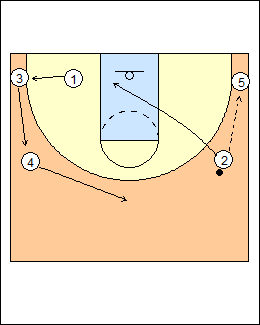 | 13 Here 2 swings the ball to 5 (another stationary pass) and basket cuts. 4 fills the top of the key (leaving a double gap). 5 can attack behind 2's cut. MacKay - fill to a double gap.
|
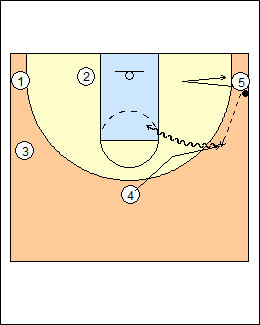 | 14 4 blast cuts for a pass after a two-count. The blast cut creates a double gap behind 4, 3 holds the wing to maintain the gap. By exiting to the short corner, 2 allows 1 and 3 to hold. 4 can immediately attack the double gap *** A basket cut on a downhill pass (top-wing, wing-corner) opens up a blast cut to reverse the ball. A passer can hold on an uphill pass (corner-wing or wing-top) as the next logical pass should be to reverse the ball, not bring it back where it came from. Screen away is another option. |
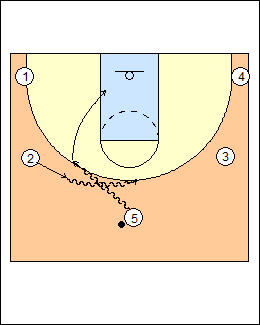 | 4) Dribble-at If the ballhandler dribbles towards your defender, get a handoff (shown), or go backdoor if your defender takes away the handoff. The player who makes a handoff can then pop or roll to the basket. Hunt - the player making the handoff should have one hand on top of the ball and the other hand on the bottom. John Carrier - the dribbler can set a Euro screen, jump stop and pivot 180 degrees to set a butt screen for the player getting the hand-off. Coach Mac - use a dribble-at when the ballhandler is heavily pressured and a pass receiver is denied (e.g. on the wing). The receiver can backcut hard looking for a pass then clear to the weakside corner, or get a dribble hand-off. He doesn't like hand-offs for youth basketball, have them automatically back cut on a dribble at. See Tactics - 3-out pass-cut-fill. Hackenberg - a crab dribble-at initiates a DHO or backcut. If the wing backcuts on a dribble-at from out top, fill from the corner, and on a pass to the fill, brush cut underneath to create a dribble-drive gap. Doug Novak - Offensive Philosophy (pdf) - nothing can stop the ball from moving. If you can't swing the ball, dribble at the next offensive player for a backdoor or throw behind. If you can't throw behind, look to snapback where you dribbled from. Single-Double Gaps - don't follow too quickly behind a dribble-at, there should be a double gap if the ball is picked up. Score with 45 Cuts - dribble-ats almost always trigger a backcut. 45 cut from the wing for a pass and layup, or create space for the corner to blast cut. Adam Spinella - Hoiberg 5-Out Concepts - 2 backcuts on a catch by 5, leading to a DHO with the corner. Hackenberg - a double backcut can break pressure, 2 then 1 backcut. See Offence - 5-out dribble-attack continuity, 5-out dribble-drive motion, also Shooting - Dribble handoffs. |
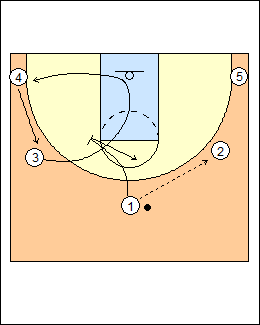 | 5) Screen away Except on a pass out of the corner, screen away after passing, instead of cutting to the basket. The cutter curls to the basket, the screener comes back where he started. Here 1 passes to 2 and screens away for 3, who curls the screen to the basket. 1 comes back to the ball, 4 fills behind 3, 3 replaces 4 in the corner. Progressions - take what the defence gives you, 1 screens away if his defender jumps to the ball to take away a basket cut - the cutter can reject the screen and backcut to the basket if his defender goes over the screen early. Huggins - the cutter always goes to the basket (curl or backcut), the screener comes back to the ball, 2 has to have someone to pass to. Have shooters screen for non-shooters, non-shooters backcut [or basket cut], they don't screen. Wissel - the elbow curl (shown here) is best used when a smaller player sets a screen for a bigger player. Petitgoue, Perkins - pass and cut against pressure defence, pass and screen away against sagging defence. Tauer - the cutter goes opposite his defender (curl if he trails, flare if he goes under, backcut if he denies), the screener goes opposite the cutter. Read your defender before looking for the ball. Coach Mac - recommends all youth basketball teams (below high school) get the cutter to curl off the screen every time so that there's no confusion (front cut or back cut). Progression - curl or pop, the screener goes opposite. Hackenberg - the screen receiver can straight cut, back cut or tight curl. One player goes towards the rim and the other pops back to the ball. The screener can screen or slip, which works best against switching defence (or the cutter back cuts). |
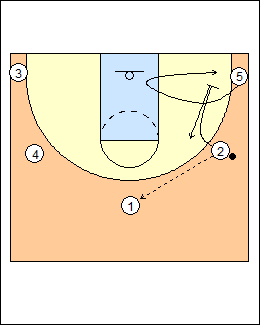 | 17 From the wing, screen for the corner or the top. Here 2 passes to 1 and screens for 5, who curls then pops back to the corner, 2 comes back to the ball. Wissel - at the baseline position, look to set up your defender to use a downscreen. Faucher - give and go (or ballscreen) from point to wing or wing to corner. Ian MacKinnon - horseshoe offence - give and go on a pass towards the basket (point to wing or wing to corner), screen for the corner on a wing to point pass (away from the basket). Hackenberg - any time they centre the ball they want a down screen and fill on the other side to occupy the defence. Reid Ouse - Mastering 2-Man Game Reads - use the over, twist the under - use a screen if your defender goes over (curl, pop), twist back (come off, catch, ballscreen) if they go under. The screener separates. The same reads apply to ballscreens, DHOs, and get action. |
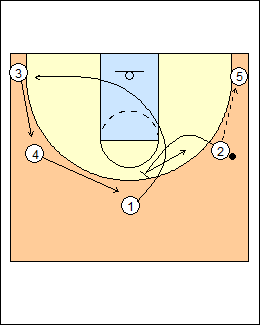 | 18 Here 2 passes to 5, screens for 1, and steps back to the ball. 1 curls the screen, 4 and 3 fill cut, 1 goes to the corner. If defenders switch on screens, the screener will be open coming back to the ball, or he can slip to the basket before screening, or set a screen on his own defender to free up the cutter (see Huggins open-post for another option, a switch cut). See Offence - 4-out 1-in motion for more on screening tactics. |
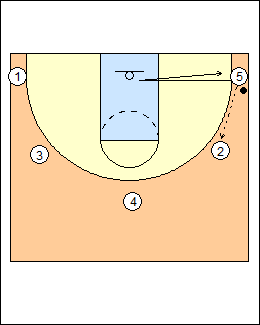 | 19 |
 | 7) Handback Pass and follow for a handback (or cut around your teammate to the basket, looking for a pass). The player making the handback can pop or roll to the basket, it's like a ballscreen. If you pass the ball to someone who can't handle pressure, you can go get the ball back. coachesclipboard.ca - follow a pass for a handback, go by the screen hip to hip, the screener rolls to the basket after the handback, looking for a bounce pass. The screener can fake the hand-back, take one dribble towards the middle and hit the cutter going to the basket. |
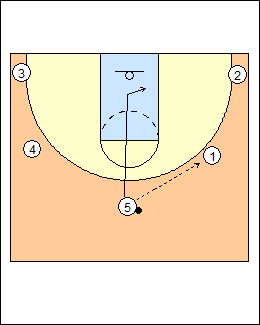 | 8) Post-up After a basket or backdoor cut, any player with an advantage in the post can post for 1-2 seconds before spacing out. An open post allows players to cut into the lane/post area rather than play with their back to the basket. Here 5 basket cuts, and can swim or sit and spin looking for a pass from 1. Any cut to the basket commits two defenders, collapses the defence, puts pressure on the rim, creates space behind for another cut or a drive, and creates post-up opportunities. Cutters 5-out motion - you can allow a good post player to cut and sit in the post for 2 seconds. Perkins - post players or a guard with a mismatch in the post can post up for two seconds after a basket cut, then fill the open spot. Hunt - drop step at the rim, this will help you decide to post or cut to open space. Here 5 can stay and post if fronted, 4 pops out top for a reversal pass to relay the ball into the post. Petitgoue - 4 fills the top for a pass, look for a high-low pass to 5 inside, there is no weakside help. Huggins - run the offence until you get 5 in the post on a basket cut or backcut, then he can post (spin and seal, or step across). Use the corner every once in a while, drag a defender out. It's good when bigs are in the corner, they can pass out, cut and post. Wissel - keep the middle open, when you cut to the basket, don't stay in the post area for more than a one-count, fill an open spot on the side of the floor with the fewest players. See Fast breaks - Triano early offence (Two down).  |
